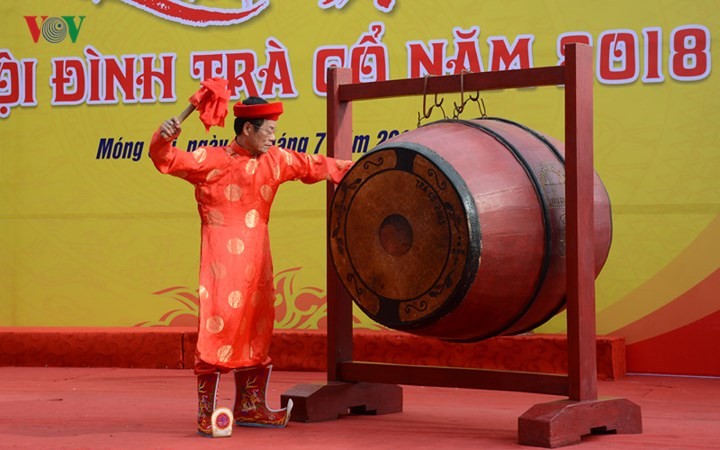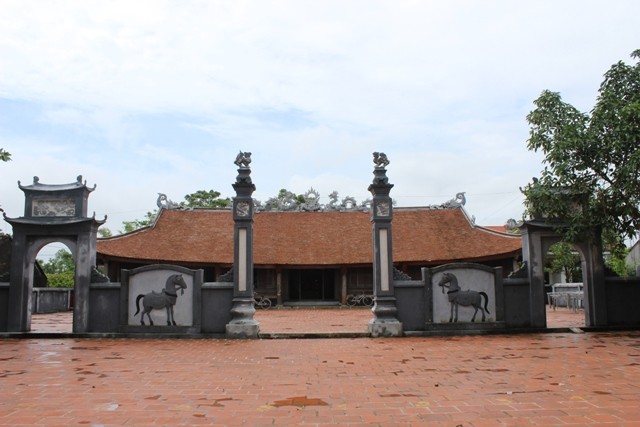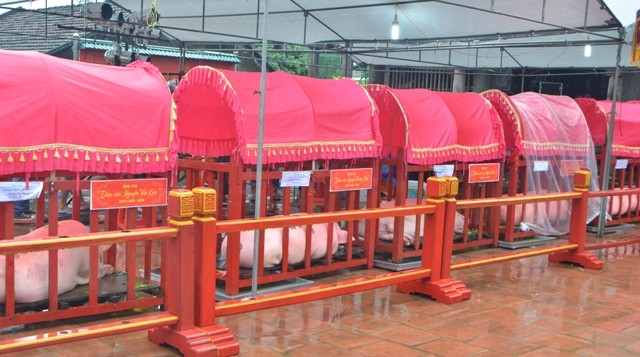(VOVWORLD) - The Tra Co communal house in Tra Co ward, Mong Cai City, Quang Ninh province, was built in the late Le Dynasty (1428 – 1788). The 600-year-old house in the Vietnamese architectural style at the center of the village is a border marker of culture and history affirming Vietnam’s territorial sovereignty.
 The Tra Co Communal House Festival lasts for 5 days begining from the last day of the fifth lunar month each year. The Tra Co Communal House Festival lasts for 5 days begining from the last day of the fifth lunar month each year.
|
The Tra Co communal house inspired songwriter Nguyen Cuong to write the well-known song “Fishing Village's Communal House” which you just heard. Despite being located on the border with China, it has a purely Vietnamese architectural style.
Nguyen Giao Te, President of the Elderly Association of Tra Co ward, says the communal house bears the historical record of the village, which the local people want to preserve.
Mr. Te said: “The Tra Co communal house is one of the oldest in the country dating back to the 16th century. All the features and worship ceremonies are totally Vietnamese. During the border war in 1979, all worship objects were removed to a safe place. In 1992, these objects were taken to Italy for a show”.
 Tra Co Communal House (Photo: Khanh Hoa) Tra Co Communal House (Photo: Khanh Hoa)
|
The house was built in the late Le Dynasty, dedicated to 6 village genies who founded Tra Co commune. Bearing the architectural characteristics typical of a coastal village, Tra Co communal house contains intricate and subtle sculptures.
The relic covers an area of 400m² and has a frame of rare wood. On the sides of the roof, the curved corners are adorned with dragon heads. Decorative carvings are crowded with mythological animals - unicorns, turtles, dragons, and phoenixes - and magical elements - flowers and clouds. The relic is famous for the dragon carvings on its doors and its transverse panels of gold and red lacquer.
In addition to aesthetic values, the Tra Co communal house preserves 12 royal decrees from the Nguyen Dynasty (1802 – 1945).
87-year-old villager Doan Thi Cu recalled: “It is said that 12 people from Hai Phong came here following a shipwreck. Six of them went back to their home village. The others stayed and built the village. They took pleasure from the scenery around the village and daily activities like fishing and water filtering.”
In a simple voice typically representing coastal people, 87-year-old Doan Thi Cu mentioned the founders of Tra Co village by citing a popular saying about the origin. Though slowed somewhat by age, whenever the drumbeat of the Tra Co village festival sounds, she goes with other villagers to the communal house to burn incense in tribute to the ancestors.
The Tra Co Communal House Festival is held on the last day of the fifth lunar month each year to honor the tutelary genies of the village and pray for the villagers.
Le Ngoc Luu, Deputy Chairman of the Mong Cai city People’s Committee, said: “The festival recalls our forefather’s contribution to the commune’s construction and their fight against foreign invaders, and teaches the younger generation about national pride. It also promotes the village’s history, culture, and architecture to visitors.”
The festival begins with a ritual procession from the communal house to a shrine to report to the village tutelary god. The procession then passes through the streets of Mong Cai city and winds up at the Tra Co Communal House.
On either side of the road, local people arrange trays of fruit in front of their house, to pray their ancestors to bring peace to the locality and help the fishermen have a prosperous year. Sacred rituals dedicated to the village tutelary genies will continue for the entire 5-day festival.
After the procession, there are many fun activities: a fattest pig competition, a cooking contest, a tug of war, walking on stilts, and traditional dancing.
Nguyen Dinh Cu, a resident of Mong Cai city, said: “This is a traditional festival so we must preserve and further develop it. All local people must be aware of its importance so that we can uphold our cultural heritage.”
The fattest pig competition is the highlight of the entertainment following the ritual procession. On the first day of the festival, the Tra Co communal house is busy with preparations for the special competition of 12 pigs to be judged the fattest. Pigs are considered a sacred animal and respectfully called “Mr. Elephant”. Caretakers for the 12 pigs are carefully chosen. They must be middle-aged, healthy, good at doing business, dignified, and lead a healthy lifestyle. Their families must live in harmony and not be in mourning at the time of the festival.
 (Photo: qtv.vn) (Photo: qtv.vn)
|
After a ritual to the ancestors, the “Mr. Elephants” are put in red-roofed cages in two lines in front of the communal house as offerings to the genie. After another ritual, the organizing board chooses the fattest pig with the longest body and biggest neck to be slaughtered as a sacrifice.
Nguyen Tuan Tai who won the 2018 fattest pig competition said his pig weighed a record 188 kilos.
“The diet for the pigs is special. The food must be delicious and clean. I feel honored,” Tai explained.
Dinh Thi Phuong, a visitor from Hai Phong, said: “This year’s festival is very crowded, but orderly. The pigs are bigger, and better cared of. This year’s festival attracted a greater number of foreign tourists.”
Nguyen Van Phuoc, Chairman of the Tra Co ward People’s Committee, said: “The local authorities, with the municipal administration’s support, will do their best to preserve and uphold the values of the communal house and its festival so that along with Cape Sa Vi, Tra Co Beach, Nam Tho Pagoda, and Cape Ngoc, Tra Co will attract visitors to Vietnam’s northeastern border.”